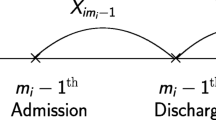Abstract
We consider ordered bivariate gap time while data on the first gap time are unobservable. This study is motivated by the HIV infection and AIDS study, where the initial HIV contracting time is unavailable, but the diagnosis times for HIV and AIDS are available. We are interested in studying the risk factors for the gap time between initial HIV contraction and HIV diagnosis, and gap time between HIV and AIDS diagnoses. Besides, the association between the two gap times is also of interest. Accordingly, in the data analysis we are faced with two-fold complexity, namely data on the first gap time is completely missing, and the second gap time is subject to induced informative censoring due to dependence between the two gap times. We propose a modeling framework for regression analysis of bivariate gap time under the complexity of the data. The estimating equations for the covariate effects on, as well as the association between, the two gap times are derived through maximum likelihood and suitable counting processes. Large sample properties of the resulting estimators are developed by martingale theory. Simulations are performed to examine the performance of the proposed analysis procedure. An application of data from the HIV and AIDS study mentioned above is reported for illustration.



Similar content being viewed by others
References
Chang SH, Wang MC (1999) Conditional regression analysis for recurrence time data. J Am Stat Assoc 94:1221–1230
Cook RJ, Lawless JF (2007) The statistical analysis of recurrent events. Springer, New York
Huang J (1996) Efficient estimation for the proportional hazards model with interval censoring. Ann Stat 24:540–568
Huang Y, Louis TA (1998) Nonparametri estimation of the joint distribution of survival time and mark variables. Biometrika 85:785–798
Huang Y (2000) Multistate accelerated sojourn time model. J Am Stat Assoc 95:619–627
Huang X, Liu L (2007) A joint fraility model for survival and gap times between recurrent events. Biometrics 63:389–397
Lin DY, Ying Z (1997) Additive regression models for survival data Proceedings of the First Seattle Symposium in Biostatistics: Survival Analysis. Springer, New York
Lin DY, Sun W, Ying Z (1999) Nonparametric estimation of gap time distributions for serial events with censored data. Biometrika 86:59–70
Schaubel DE, Cai J (2004) Regression methods for gap time hazard functions of sequentially ordered multivariate failure time data. Biometrika 91:291–303
Sun LQ, Park DH, Sun JG (2006) The additive hazards model for recurrent gap times. Stat Sin 16:919–932
Visser M (1996) Nonparametric estimation of the bivariate survival function with an application to vertically transmitted AIDS. Biometrika 83:507–518
Wang W, Wells M (1998) Nonparametric estimation of successive duration times under dependent censoring. Biometrika 85:561–572
Wang W, Ding AA (2000) On assessing the association for bivariate current status data. Biometrika 87:879–893
Wang MC, Qin J, Chiang CT (2001) Analyzing recurrent event data with informative censoring. J Am Stat Assoc 96:1057–1065
Wang MC, Chiang CT (2002) Nonparametric methods for recurrent event data with informative and non-informative censorings. Stat Med 21:445–456
Zeng D, Lin DY (2006) Efficient estimation of semiparametric transformation models for counting processes. Biometrika 93:627–640
Acknowledgments
This research was supported by Taiwan Ministry of Science and Techonology Grant 103-2118-M-305-003.
Author information
Authors and Affiliations
Corresponding author
Appendices
Appendix 1: Proof of Theorem 1
First we shall show that \(\frac{1}{\sqrt{n}} \sum _{i=1}^n\varvec{U}_i(\varvec{\varOmega })\) at \(\varvec{\varOmega }_0\) converges to a multivariate normal distribution, where
Note that \(\varvec{S}_{ki}, k=1,2,3\), have been defined in (8). By the multivariate central limit theorem, we have \(\frac{1}{\sqrt{n}} \sum _{i=1}^n\varvec{S}_{1i}(\varvec{\varOmega }_0) \rightarrow N\left( 0, E\left\{ -\frac{1}{n}\sum _{i=1}^n\frac{\partial \varvec{S}_{1i}(\varvec{\varOmega }_0)}{\partial \varvec{\varOmega }}\right\} \right) \). Since we assume that \(dN_{2i}, dN_{Ci}\) cannot jump simultaneously and two counting processes are conditionally independent to \(\delta _{1i}\) given \(Z_i\),
are asymptotically independent. Based on martingale central limit theorem and regular assumptations \(\text{(A1) }-\text{(A5) }\), we have
Furthermore, the differential of \(-\frac{1}{n}\sum _{i=1}^n\varvec{U}_{i}(\varvec{\varOmega })\) with respect to \(\varvec{\varOmega }\) is
By \(\text{(A3) }\)–\(\text{(A4) }\) we have the first two terms on the right-hand side of (9) converge to \(\mathscr {I}_0\), and the third term is \(o_p(1)\) because the sum is scaled by \(n^{-1}\). So with the Taylor expansion of \(\frac{1}{n}\sum _{i=1}^n\varvec{U}_{i}(\widehat{\varvec{\varOmega }})\) around \(\varvec{\varOmega }_0\), we have
where \(\varvec{\varOmega }^{*}\) is on the line segment between \(\varvec{\widehat{\varOmega }}\) and \(\varvec{\varOmega }_0\). Therefore, by Slutsky’s theorem and \(\varvec{\widehat{\varOmega }}\rightarrow \varvec{\varOmega }_0\) almost surely, Theorem 1 is established.
Appendix 2: Information matrix
For \(s,l \in \{1,2,C\}\), the differential of \(-\frac{1}{n}\sum _{i=1}^n\varvec{U}_{i}(\varvec{\varOmega })\) for each parameter are given
Rights and permissions
About this article
Cite this article
Huang, CH., Chen, YH. Regression analysis for bivariate gap time with missing first gap time data. Lifetime Data Anal 23, 83–101 (2017). https://doi.org/10.1007/s10985-016-9370-3
Received:
Accepted:
Published:
Issue Date:
DOI: https://doi.org/10.1007/s10985-016-9370-3




